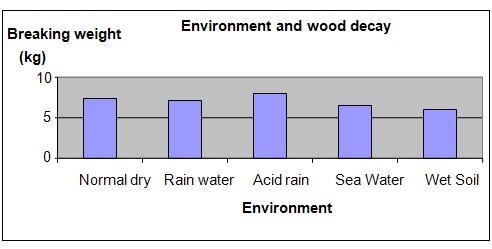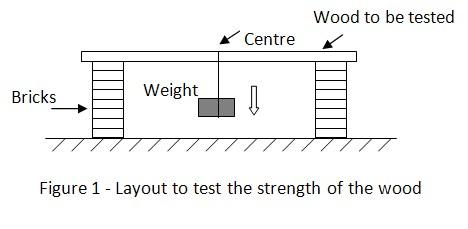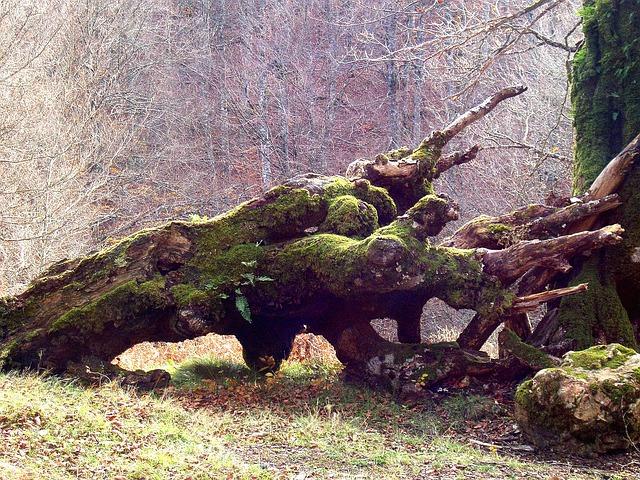| Complexity level: | 7 |
| Project cost ($): | 90 |
| Time required: | 1 day to prepare, 18 days for observation |
| Material availability: | Most of the materials may be purchased at a supermarket. You can purchase the wood from a hardware store (Eg. Home Depot, Lowes) |
| Safety concerns: | Basic safety requirements |
Hypothesis
The wood samples that were immersed in soil will start to decay and become weaker at a faster rate.
Overview
Wood decay
The decay in wood is caused mainly by water and fungi. Among the causes of decay in wood used in the construction of houses include the condensation of water vapor on wooden window frames, the leaking of rainwater through the roof and walls, dripping water from poor plumbing, and water that gathers around toilet bowls, all of which are absorbed by the wooden structure of the house.
In the presence of water or water vapor, the wood will expand and shrink, causing dimensional changes, and this accelerates the degradation of the wood and its finish. Basically wood will swell when it is exposed to water, and will shrink back when it dries. Over-exposure to water at 100% humidity, or being immersed in water will cause the wood to expand beyond the saturation point of its fibers. This will reduce the wood’s strength and accelerate its decay.
The fungi that is responsible for wood decay will need the correct temperature, along with sufficient moisture, oxygen and nutrients from the wood in order to survive. The fungi will cause decay through the secretion of enzymes. These enzymes help to break down the cellulose in the wood into sugar, which the fungi use as food. However water is required to transport the sugar to the fungi. Therefore without water, the wood cannot decay.
Scientific Terms
Materials
The materials required for this science fair project:
- 20 oak wood planks (proposed size 50mm x 25mm x 500mm)
- 16 bricks
- 20 weights, each of 0.5 kg
- Tap water
- 1 pail of rain water (the water should be collected in an open field, away from trees, roof edges and other obstructing objects)
- 1 bottle of vinegar
- 1000 grams of salt
- 4 pails (minimum 500mm in height)
- Soil
- 1 rope, of about 2 meters’ length
- pH paper
- 1 black marker pen
Procedure
1. For this science fair project, the independent variable is the environment in which the pieces of wood are kept for 2 weeks – whether in rain water, acid water, salt water or wet soil. The dependent variable is the average strength of the wood after 2 weeks. This is determined by applying weight to the planks and noting the breaking point of the wood. The constants (control variables) are the size of the wooden planks used, the length of time they are exposed to the environment, and the type of wood used.
2. The experiment is begun by inspecting the dimensions of the wooden planks and ensuring that all 20 are of the same size. The 20 planks are divided into 5 groups of 4 planks each. All the planks in each group are labeled with the group’s letter – either A, B, C, D or E.
3. The 4 pails are marked as either B, C, D or E. The pails are prepared as follows:
a. Pail B is filled with rain water. The 4 planks labeled B are placed inside it.
b. Pail C is filled with a mixture of water and vinegar, using an appropriate concentration of vinegar such that pH 4.5 is obtained. This is used to simulate acid rain. The 4 planks labeled C are placed inside it.
c. Pail D is filled with water and salt. 40g of salt is added to every liter of tap water. This is to simulate sea water. The 4 planks labeled D are placed inside it.
d. Pail E is filled with soil. Water is added to the soil daily to keep it wet. The 4 planks labeled E are placed inside it.
4. The planks labeled A are not placed in any pail. They are left in a dry place and protected from accidental exposure to moisture.
5. The wooden planks are left in the respective environments mentioned above for 2 weeks. After that they are taken out of the pails and left to dry for 3 days.
6. The strength of the wooden planks is tested using the set-up shown in Figure 1 below. 2 stacks of 8 bricks each are placed some distance apart, and the piece of wood to be tested is placed across the stacks of bricks. The weights are hung from the center of the plank, as shown. More weights are added, 0.5kg at a time, until the plank breaks. The average weight that caused the plank to break in each group is calculated and recorded in the table given below.



Results
It was observed that the wooden planks that were kept in the moist soil were the weakest among the 5 groups.
| Condition | Normal dry | Rain water | Acid rain | Sea Water | Wet Soil |
| Average breaking weight (kg) | 7.5 | 7 | 8 | 6.5 | 6 |
We used the graph below to plot the results of the above observations.

Conclusion
The hypothesis that the wood immersed in the soil will start to decay and become weaker at a faster rate is proven to be true.
Wood is used to build many structures and in the making of furniture. The application of wood in construction will depend on its properties, like strength and durability. Other factors may include the finishing and maintenance requirements. Paint and varnish coating help to give wood a pleasant appearance, and also make it last longer.
Also consider
What would happen if the science fair project was conducted using other types of wood like Pine, Fir, Hemlock or Birch?
Try repeating the experiment, this time exposing the wood for different lengths of time (1 week, 2 weeks etc) in order to study the rate at which the wood will weaken.
References
Wood preservation - http://www.forestprod.org/cdromdemo/wp/wp4.html
About exposed wood - http://www.chemisys.com.au/cutek/exposedwood.htm

